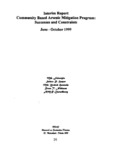| dc.contributor.author | Jakariya, Md. | |
| dc.contributor.author | Haque, Salma R. | |
| dc.contributor.author | Hossain, Md. Zabed | |
| dc.contributor.author | Nickson, Ross T. | |
| dc.contributor.author | Chowdhury, AMR | |
| dc.date.accessioned | 2020-01-07T06:10:49Z | |
| dc.date.available | 2020-01-07T06:10:49Z | |
| dc.date.issued | 1999 | |
| dc.identifier.citation | Jakariya, M., Haque, S. R., Nickson, R. T., Hossain, M. Z., & Chowdhury, A. (1999). Interim report community based arsenic mitigation program: successes and constraints June - October 1999. Research Reports (1999): Social Studies, Vol – XXIV, 36–79. | en_US |
| dc.identifier.uri | http://hdl.handle.net/10361/13409 | |
| dc.description.abstract | The severity of the problem of arsenic in ground water in Bangladesh is now well
recognized. 97% of the population relies on ground water for drinking and cooking
purposes and it is estimated that one third of the country may arsenic in the
subsurface. This amount to many millions of people potentially at risk.
The source of the arsenic is geological and due to the sedimentary processes which lead to
accumulation of arsenic and release to groundwater the level found in tubewell water are
spatially variable-one wen may be highly contaminated whereas nearby another is not The
severity of arsenic poising. or arsenicosis, also varies dependent on the length of exposure,
the level of arsenic being ingested and the socio-economic status of the individual concern.
BRAC, a non-governmental organisation, in conjunction with DPHE/UNICEF have begun
efforts to assess and mitigate the arsenic problem in two thanas of Bangladesh - Sonargaon
and Jhikorgacha.
Testing has SO far been carried out in two unions- Boiderbazar union of Sonargaon Thana
and Godkhali union of Jhikorgacha Thana - 61% and 35% of these wells respectively were
contaminated with arsenic above the Bangladesh standard of 0.05 mL
Installation and assessment of safe water options has begun. The options being advocated
are: treatment of ground water with home based candle filters, treatment of surface water
with Pond Sand Filter (PSF) : connection of Rain Water Harvesters (RWH) and use of
shallow groundwater through Dug wells.
These options are being assessed on several criteria: initial and running costs; ease of
implementation and maintenance; continuity of supply; susceptibility of
bacteriological contamination and acceptability to the community.
All of these options haw their limitations and none are as easy as obtaining tubewell water
directly, however, at present home based filter are proving most popular due to low cost,
ease of use and acceptability. Continued manufacturing quality of these home based filter
must be ensured and the lifetime of the candle assessed. | en_US |
| dc.language.iso | en | en_US |
| dc.publisher | BRAC Research and Evaluation Division (RED) | en_US |
| dc.subject | Arsenic mitigation | en_US |
| dc.subject | Rural community | en_US |
| dc.subject | BRAC | en_US |
| dc.subject | NGOs | en_US |
| dc.subject.lcsh | Water--Purification--Arsenic removal | |
| dc.subject.lcsh | Arsenic--Toxicology | |
| dc.subject.lcsh | Water--Pollution | |
| dc.subject.lcsh | Arsenic--Environmental aspects | |
| dc.title | Interim report community based arsenic mitigation program: successes and constraints June - October 1999 | en_US |
| dc.type | Research report | en_US |

